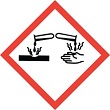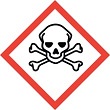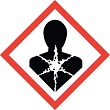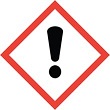Many chemicals have inherent properties that can negatively impact the human body and its functions. The hazards of some chemicals are extensively studied, well-understood, and have been published in the literature or in textbooks. These chemicals are assigned hazards that are communicated to the researcher through pictograms and hazard statements.
However, it is important to keep in mind that new experimental compounds and compounds that are derived from well-studied chemicals may pose unknown or unexpected health hazards and should be handled as such. If you are handling a new and untested substance, treat them as potentially harmful, and minimize any exposure through absorption, inhalation, or ingestion.
Minimizing Risk
The primary means to avoid suffering negative health effects from chemicals is to minimize the risk of exposure. The first step in this process is to perform a risk assessment for the compounds you will be handling. Then, employ practices that follow the Hierarchy of Controls, which include using properly-functioning engineering controls (such as chemical fume hoods) and the appropriate PPE (both type and material) for the hazards with which you are working.
Good work practices for storing, weighing, and handling chemicals will also reduce your risk of exposure. Flammable material storage cabinets and analytical balances can be ventilated, for example, to remove harmful vapors so that they are not inhaled by the researcher. Controlling and monitoring your laboratory’s inventory of chemicals also reduces the risk of potential chemical exposure. The less harmful chemicals on hand, the lower the chance that you will come in contact with the chemicals.
It is commonplace for new labs to take ownership of chemicals from previous groups (legacy chemicals); these chemicals should be cataloged and sorted when received to determine whether or not they are needed. In some instances, reagents are old enough that their containers have degraded, which increases risk of exposure. Furthermore, many reagents that are decades old are likely not usable without significant re-characterization and purification.
DRS recommends disposing of old and/or legacy chemicals, unused reagents, and materials that are no longer needed on a regular basis. You can request a waste pickup through DRS here.
Types of Health Effects
A chronic health effect is an adverse health effect resulting from long-term exposure to a substance. Symptoms do not usually subside when the exposure stops. Examples of chronic health effects include asthma and cancer.
Acute health effects can be observed immediately or soon after an exposure; often a large, brief exposure. Many times the symptoms will subside after the cause is removed, however, depending on the amount/dose, permanent damage or even death can occur from a single exposure. Examples of acute health effects include dizziness, skin irritation, and throat irritation.
Keep in mind that a chemical may cause both acute and chronic effects. Health effects can vary depending on the organ, the dose level, frequency, duration, and route of exposure (inhalation, skin contact, etc.).
Ethanol is an excellent example of a compound that causes varied health effects based on the parameters mentioned above. A small amount of ethanol (from alcoholic beverages) over several hours results in loss of coordination and impaired judgement; large one-time consumption leads to vomiting, unconsciousness, or even death; consumption over several days by a pregnant person can lead to birth defects; and chr:onic consumption over many years can lead to cirrhosis of the liver.
Some chemical hazards that negatively impact human health are identified in the table below (this list is not all-inclusive)
Systemic Effects | Target Organ Effects | Other Health Hazards |
|
|
|
Proposition 65 List
The Proposition 65 list is a comprehensive list of the chemicals that are known to cause cancer, birth defects, or other reproductive harm. The list is updated regularly and the most recent list should always be referenced. The list can be found at the following website: https://oehha.ca.gov/proposition-65/proposition-65-list
Globally Harmonized System (GHS)
The Globally Harmonized System (GHS) defines health hazards as one of three hazard groupings. Within each of the hazard groups there are classes and categories. Each category has rules or criteria to determine what chemicals are assigned to that category. Categories are assigned numbers, sometimes with an additional letter. Category 1 or 1A is the most hazardous.
Pictograms are also used to identify chemical hazard classification within the GHS. Chemicals with health hazards may be labeled with the pictograms shown below.
Hazard | Pictogram | Definition/Description | Common Examples |
Corrosive |
| Causes visible destruction of, or irreversible alterations in, living tissue by chemical action at the site of contact. | Sodium Hydroxide |
Acutely Toxic |
| A chemical is a toxic agent or highly toxic agent based on the number of deaths that occur in a sample population of rats following acute exposure. The analysis is based on the LD50 (median lethal dose by oral or dermal exposure) and LC50 (median lethal inhalation concentration). The LD50 and LC50 represent the dose or concentration that kills 50% of a test population. | Toxic Agents: Sodium Azide
Carbon monoxide |
Health |
| A generic term used to describe chemicals with various adverse health effects. These include:
Carcinogens: capable of causing cancer in living tissue. Mutagens: capable of causing genetic mutation. Reproductive Toxins: cause chromosomal damage, affect fetal development, and alter germ cells (sperm and ova). Respiratory Sensitizers: irritate or damage lung tissue. Target Organ Toxins: affect various organ systems including: liver/gallbladder/ bile duct (hepatotoxin), kidneys (nephrotoxin), brain (neurotoxin), lungs (respiratory toxin) and blood (hemato/hematopoietic toxin). | Carcinogens: Carbon Tetrachloride, Benzene, Chloroform Mutagens: Benzene, Sodium Azide, Ethidium Bromide Reproductive Toxins: Lead, Hexane Respiratory Sensitizers: Ozone, Nitrogen Oxides Target Organ Toxins: Nephrotoxic- Heavy Metals, Halogenated Hydrocarbons Neurotoxic- Hexane, Lead, Mercury |
Irritant
Acutely Toxic (Cat 4) |
| A chemical, which is not a corrosive, but which causes a reversible inflammation by chemical action at the site of contact. Hazard subclasses of irritants include (but are not limited to):
Acutely Toxic (Category 4) displays this symbol. These substances are harmful but only cause lethal effects after exposure to large amounts. | Skin Irritants: Halogenated Aromatics, Mercury, Hydroquinone, Arsenic
Acutely Toxic (Cat 4): Benzoyl chloride |
Signs and symptoms of chemical exposure
Signs of an exposure are external and can often be seen by you or others in the laboratory. They are objective and can sometimes be measurable. Signs of exposure sometimes include hives, puffiness, sneezing, etc. They are often temporary and can go away when the source of the exposure is removed.
Symptoms are internal and are not visible to the naked eye. They are only felt by the person feeling them and examples include pain, dizziness, numbness, etc.
Sometimes a sign can indicate a symptom. For example vomiting is a sign than indicates someone is feeling nauseated (symptom).
There are different signs/symptoms of exposure to chemicals based on their hazards, reactivity, and the route of exposure. Many of the signs and symptoms of exposure to chemicals are similar, but there are some specific signs which are indicative of particular compounds. For example, osmium tetroxide vapors damage the cornea of the eye, can make your eyes feel gritty, and even turn them black. It is important to know the signs and symptoms of the chemicals with which you work and other chemicals in the laboratory to which you could potentially be exposed.
Skin Absorption | Ingestion | Inhalation | Eye Contact |
|
|
|
|
This list is not comprehensive—those researchers with sensitivities or allergies to certain compounds may experience different or more severe symptoms.
If you experience one or any combination of these symptoms after one-time or continued exposure to hazardous chemicals, seek medical attention according to the procedures found in the Lab Safety Guide/Chemical Hygiene Plan.
Best practices and procedures
Working with any hazardous chemical requires training on the hazards and how to mitigate risk of exposure or an incident. Standard Operating Procedures are required by the OSHA Lab Standard. DRS provides guidance for how to create these SOPs for a research environment. The most important thing to keep in mind when working with chemicals that have negative health effects is to protect your body from incidental exposure as stated above.
Personal Protective Equipment
Personal Protective Equipment (PPE) is the last line of defense against exposure to hazards. For hazards with health effects this is an important means to protect yourself even if you have minimized risk of exposure. Most chemical splashes are accidental and not anticipated. PPE has saved many people from permanent damage to their body or loss of sight. When PPE becomes contaminated it is important to remove it immediately since many chemicals can penetrate PPE.
Minimum PPE when working with materials that have health effects includes lab coat (or similar clothing cover), gloves, and eye protection.
Not all PPE will provide the same level of protection. Make sure the SOP written for the chemical specifies the exact type of PPE required.
More information about PPE is found here.
Facilities
Only work with these chemicals in proper facilities. The facility must house the necessary equipment to limit the risk for exposure as well as provide the means to address an exposure if one occurs. You should not handle chemicals with health hazards in facilities without proper ventilation or emergency equipment.
Engineering controls like chemical fume hoods are usually the best control to protect the user from chemical exposure to vapors and dusts.
Emergency eyewashes and showers are occasionally used on campus. It is important to have these available when working with materials that have negative effects through skin exposure/absorption or eye contact.
Particularly Hazardous Substances (PHS’s)
The OSHA Lab Safety Standard defines select carcinogens, reproductive toxins, and acute toxins as “Particularly Hazardous Substances”. A list is provided here, but it is only a guide and is not all inclusive. Safety data sheets must be reviewed to identify if a chemical falls into one of the above categories. A Standard Operating Procedure must be written that details how researchers should protect themselves from the hazards of the PHS.
One of the key requirements of the OSHA Laboratory Standard for working with PHS’s is to ensure the substances are confined to designated areas. A laboratory, an area of a laboratory, or a specific fume hood are all examples of designated areas. Warning signs should be placed on these areas to notify all personnel of the hazardous substances in use.
Below are key practices to implement when handling PHS’s:
- Never work alone when handling a PHS.
- Avoid all skin contact with PHS’s by wearing appropriate PPE. List the required PPE in your Standard Operating Procedure for handling this compound.
- If the PHS is highly volatile or if the procedure generates aerosols, the procedure must be done in a chemical fume hood to minimize inhalation of toxic vapors, mists, gases, or dusts.
- Minimize potential incidents and spills by storing the PHS in secondary containers made of polyethylene or another chemically resistant material. Similarly, any apparatus used for the procedures should be mounted above containers of the same material.
- Vapors discharged from experiments involving PHS’s should be trapped or condensed to avoid toxic vapors being released through the hood exhaust air. PHS’s should never be disposed of by evaporation.
- Protect all vacuum lines with traps to prevent PHS’s from entering vacuum systems.
- Keep a current inventory of all of the PHS’s stored and utilized in a research group.
- Remind yourself where the emergency equipment (shower and eyewash) is located in your laboratory.
- Decontaminate work surfaces at the end of the procedure or work day.
Helpful Tips
In order to weigh out odorous and/or highly toxic chemicals, pre-weigh a sealable container prior to adding the chemical. In a fume hood, add the chemical to the container. Close both the pre-weighed container and the chemical container in the hood. Then bring the sealed container to the same weighing station and calculate the difference. Repeat this process until you have the desired mass of the chemical for your work. Avoid opening the container outside of a working fume hood to minimize potential exposure.
Vented enclosures for balances are also available for purchase. If you are using a vented enclosure, be sure that the unit is connected to an appropriate exhaust system. Biological safety cabinets should NOT be used for these applications; BSCs will re-circulate air throughout the laboratory, which defeats the purpose of using an exhausted enclosure in the first place.
In some cases, you may want to double-glove (i.e., don an additional pair of disposable gloves) when handling certain chemicals. Ensure that the gloves are made of a material which is compatible with the compound in question.
Emergency Procedures
If you think you have been exposed to a hazardous compound, consult the Safety Data Sheet (SDS). Section 4 of the SDS will contain first aid information. If you seek medical attention for a chemical exposure, be sure to bring the SDS with you to show medical staff.
For many chemicals, the following first aid measures are appropriate:
Skin Contact
Remove contaminated clothing and rinse off affected skin immediately with copious amounts of water at a shower station for 15 minutes or until pain is relieved. Seek medical attention, especially if skin is irritated or damaged.
Eye Contact
Use the eyewash to rinse the eyes thoroughly for at least 15 minutes, occasionally lifting upper and lower eyelids, moving the eyeballs around. Seek medical attention.
Inhalation
Move to fresh air immediately. Seek medical attention if symptoms persist. Provide the medical team with the SDS for the chemical to which you were exposed.
Spills
If the spill requires evacuation (complicated spill), first evacuate and then call 911 immediately. Contact DRS to report the spill.
Spills should only be cleaned up by personnel wearing suitable PPE.
Any spills should be cleaned up immediately, using absorbent pads or other absorbent material such as sand or cat litter. Have enough material readily available before working with the chemicals. Do not use paper towels to soak up liquids if the compound is also flammable. Place the used absorbent material into a heavy-duty plastic bag (if the solvent will not dissolve the plastic) or sealable container and dispose of as hazardous waste through DRS.
More information is outlined on our Chemical Spill page.
Fires
Take the campus Fire Extinguisher Training. Have a fire extinguisher readily available when working with flammable materials. Consult the SDS for the appropriate fire extinguisher before you begin working with the chemical


